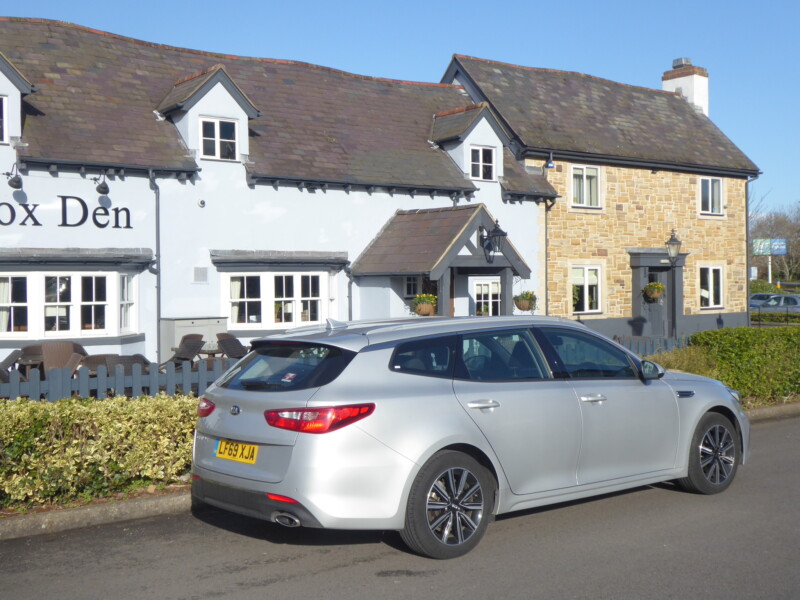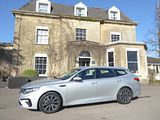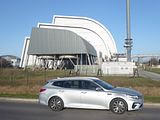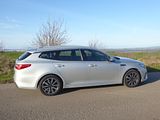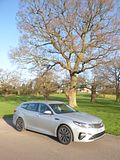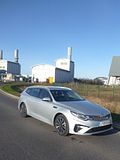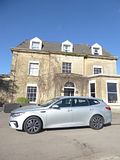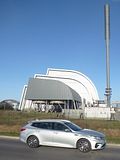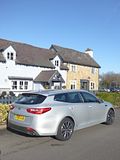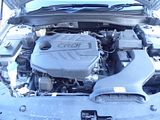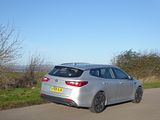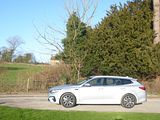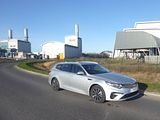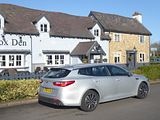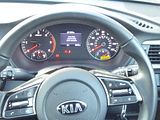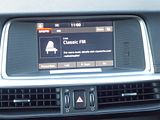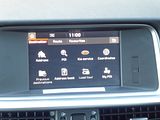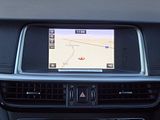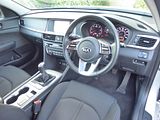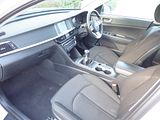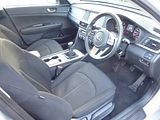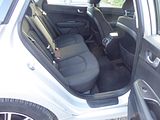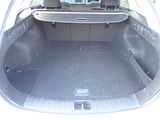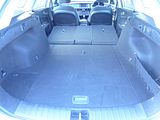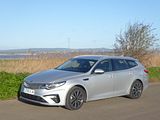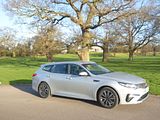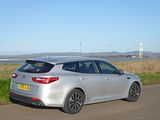The growth in sales of Kia cars in the UK and indeed the rest of Europe over the last 20 years or so has been quite spectacular. Even in the early days, every new model was a significant advance on what went before, but it was really with the launch of the second generation Sportage in 2005 and then the European designed and built Cee’d of 2007 that sales took off. Hiring renowned designed Peter Schreyer who had been at Audi transformed the external appearance of the cars, which with their “tiger shark” grilles were universally neat and pleasing without being fussy and the interiors also started to take on the sort of style that Audi has been using to great effect for some years prior. Add in generous levels of equipment and the industry-leading 7 year warranty and it is no surprise that the cars suddenly became desirable. But not every Kia has managed to grow its sale success at the same rate, though. The model that has always struggled is the Korean’s entrant in the D-Segment, the Optima. To some extent it has been a victim of the fact that this segment has been diminishing at a rapid rate as buyers move either to cars with a premium badge or some form of cross-over, so even the class sales leaders such as the Ford Mondeo and Vauxhall Insignia have also fallen from favour big time. Kia have not given up, though, and although there was some debate about whether to bother, the latest, fourth generation Optima saloon arrived in the UK in late 2015. The market seemed barely to notice, though when I rented one towards the end of 2016, I found a car that had plenty of virtues and no obvious reason to shun it in the way that the buyers continued to do. Noting that estate versions of D-Segment cars are now outselling their saloon relatives in most cases, Kia decided to add an estate model to this generation Optima. Styled in Europe, and with European sales the main objective, this made its debut at the Geneva Show in 2016, and it drew much praise for the elegance of the design. Sadly, it has not done much to improve the UK sales performance of the Optima, though. The rental fleets have bought some, as they tend to have a strong Kia presence, and the saloon and estate (or Sports Wagon, as Kia call it) fit perfectly against their needs for a large family saloon and estate car in their fleets. In the third of a series of back-to-back rentals from London Heathrow, I was pleased to see that Hertz had allocated one to me, so I could get the chance to try the latest version of the Optima and with the estate body.
Although petrol engines feature in Optima models in other markets, such as the US, where the car is a strong seller, when launched in the UK, the Optima was only offered with a 1.7 litre diesel engine, and indeed this featured in the saloon car I drove in 2016. Kia did add other choices, soon after, though, including a 2.0 litre PHEV that they hoped would appeal to company car drivers. This had combined a 155PS 2.0-litre direct-injection petrol engine with a 50kW electric motor. When working together, the combustion engine and electric motor generate 205PS and 375Nm of torque, while CO2 emissions ranged from 33-37g/km. There were also a couple of petrol engines, as seen in US market cars, both of them powerful four-cylinder turbos, with the 180PS 1.6-litre T-GDi and 245PS 2.0-litre T-GDi powering the high-performance Optima GT. The 180PS unit came paired with the seven-speed double-clutch transmission as standard. For the mid-cycle facelift in mid 2018, the 1.7 litre diesel was replaced by Kia’s new 1.6 litre CRDi, with slightly less power, but lower emissions and greater efficiency. All Optima models sold in the UK after this facelift now have the same 1.6 CRDi diesel engine. It puts out 136 bhp, which is about average for cars of this size. The priority here was for a comfortable cruiser rather than anything particularly sporty and with that as the brief, Kia was nailed it. This is a very refined engine, with no diesel noise to speak of that is evident from inside the cabin. An automatic gearbox is available in higher trim versions, but the test car, being the entry level 2, had a six speed manual box. The gearchange is good, with the lever moving readily between the ratios. First gear is very short, useful only when moving away from standstill, but after that there is plenty of torque and the Optima pulls well. The result is that whilst the standard start acceleration times are nothing to get that excited about, in the real world where you need some sudden acceleration, the Kia does quite well. Once at a steady speed, this car is very refined and pleasingly quiet on the motorway, so this is definitely a car that would be great for a long journey. And you could certainly do that without needing to stop, if you wanted to. I drove the car 110 miles home and the fuel needle had not moved, still showing as “full”. Each journey that I undertook that was reported by the car as averaging somewhere between 46 and 50 mpg. I covered a total of 403 miles and needed to put in 39.3 litres to fill it up. The car features what Kia refer to as ISG, their Intelligent Stop & Go, a Stop/Start system, and this worked as unobtrusively as these systems do. Continued pressure to reduce emissions means that smaller engine diesel cars are now being fitted with AdBlue systems, and the Optima has indeed received this technology now.
Given the brief of being a comfortable cruiser, this is not really a sporty car to drive, but there is nothing really to cause disappointment here, either. Sure, the steering is light but there is some feel. This is a typical large front driver with very safe and predictable handling, with the car showing some understeer as you tackle the bends with increasing enthusiasm. I think you would have to do something rather ill-advised to get into trouble, though. More importantly, the Optima rides well. Entry level cars such as this one come on 215/55 R17 wheels and by all accounts these are the best for ride comfort, the larger wheels and stiffer suspension of the top models detracting from this somewhat. The brakes worked well, though I did find that the electronic handbrake, which you do need to use as this is a manual car, could be a bit jerky when disengaging. Visibility is generally good and there is a rear-view camera to help out when reversing.
Kia worked hard with this generation of Optima to make it look and feel of higher quality inside than was the case for its predecessors. And they have largely succeeded, with something which not only looks good, but which proves easy to use. There is a choice of single- or two-tone colour interior schemes: single-tone (black) or two-tone (dark grey with light grey) in cloth or leather trim. The console is finished in gloss black and chrome. There is a leather-wrapped steering wheel and there are plenty of soft squishy materials on dash, of decent quality. There are some harder materials, though, with the door casings not quite hitting the same standard as the dash. Kia will tell you that the dashboard is divided into an upper ‘display’ zone and a lower ‘control’ zone, ensuring drivers need never take their eyes off the road in order to see the key information displayed. The central fascia is angled 8.5 degrees towards the driver, with the upper ‘display’ zone housing a new 8.0-inch touchscreen infotainment system and lower ‘control’ zone offering fewer buttons than the outgoing Optima to manage the various cabin functions that aren’t already built into the touchscreen. Within that display zone, there are two large dials, for speedometer and rev counter, with two smaller ones inset, for fuel level and water temperature. They are clearly marked and easy to read. The same stalks feature as I found in the Ceed I drove a couple of weeks prior to this test. The lights, including an auto function are on the left hand stalk. There is an auto function for the wipers, which are on the right hand stalk. The steering wheel hub contains plenty of buttons, with audio repeaters and Bluetooth on the lefthand spoke, and cruise control and the selector for trip display functions on the right. The centre of the dash contains a small integrated infotainment touch screen. Thankfully, there are still a row of buttons for some of the more commonly used audio functions. It has been upgraded to include the sort of functions that buyers expect these days, so it includes Android Auto and Apple CarPlay. Both systems feature voice control and allow the driver to keep their hands on the wheel and eyes on the road ahead at all times. The touchscreen infotainment system is paired with a six-speaker audio system as standard, while music lovers can also specify a powerful 590-watt Harman Kardon Premium Sound system, with eight speakers, an external amplifier and subwoofer, and Clari-Fi MP3 restoration technology. Below this unit are the controls for the dual zone climate control.
Lower spec models, such as this 2 version get cloth upholstery and seat adjustment is all manual. Combine a wide range of movement in all directions with a telescoping steering wheel which goes in/out and up/down and it was easy to get the driving position I wanted, and I am sure just about anyone else, of whatever proportions would be able to do the same. The seat itself proved very comfortable. This generation of Optima is slightly larger than its predecessor, which has been used to make more space available for passengers, with the result that there is a huge amount of space in the rear. Even with the front seats set well back, there is ample legroom. There is a noticeable transmission tunnel though it is quite narrow and the central console does not come back as far as is the case with some cars. That means that three adults should fit in here quite comfortably, something that the many taxi drivers who use an Optima could doubtless confirm. Headroom is more than sufficient. There is a drop-down central armrest. Map pockets feature on both front seat backs and there are some bins on the doors for odds and ends.
Most people would choose this version of the Optima rather than the saloon because they want a larger and more versatile load area and that is exactly what they will get. With the rear seats erect, the boot is 42 litres bigger than the saloon’s by volume (552 litres against 510 litres), and it is far more useful by virtue of the load deck being 1090mm long and 1010mm between the wheel arches. There is quite a bit of intrusion from the rear suspension, so it does widen out to an even more useful 1380mm behind the arches for carrying bulky items, like golf clubs. This is smaller than a Skoda Superb Estate’s boot, but then pretty much everything is and the Optima is on the large size for luggage space in its class. A Mazda 6 Estate has a 506-litre boot, for example, and a Ford Mondeo 500 litres. The Optima has a 40/20/40 split folding rear bench as standard, which is even better than the more usual 60/40 split that you more commonly find in most cars. The boor floor is flat and is available with all manner of accessories (nets and such) to help secure small items when needed. Inside the cabin, there is also generous provision for odds and ends with a good-sized glovebox, a central armrest cubby, good-sized door bins and a recess in front of the gearlever.
The Optima follows Kia’s established naming convention for trim levels. Just as with the Ceed, there is no 1, but there are 2, 3 and 4 versions. The 2 is the entry level, and this was the spec of the test car, It is well equipped, coming with 17-inch alloy wheels, auto lights, auto wipers, power lumbar support, dual-zone climate control, electric windows, cruise control, speed limiter, DAB radio, seven-inch touchscreen, Apple CarPlay support, navigation, Bluetooth, front and rear USB ports, roof rails, luggage partition and one-touch folding rear seats. The 3 adds 18-inch alloy wheels, part faux-leather upholstery, four-way power lumbar support, power adjustable driver’s seat, heated front seats, heated steering wheel, upgraded audio system, eight-inch touchscreen and lane-keep assist. Next in line is the 4, which adds DCT automatic transmission, blind spot warning, rear cross traffic alert, adaptive cruise control, autonomous emergency braking, automated parking, wireless mobile phone charging, 360-degree parking camera, leather upholstery, ventilated front seats, rear door window blinds and a smart keyless system. At the top of the range there is a GT-Line S which also adds LED fog lights, 18-inch aluminium alloy wheel, black mirror caps, side sills and air intake grille, twin exhausts, ambient cabin lighting and black leather seats with red stitching.
I rather liked this Optima SportsWagon. It is good to look at, it is comfortable to drive, being a particularly relaxed long distance cruiser and it is very spacious. Add in good levels of equipment, and Kia’s reputation for reliability, that 7 year warranty and very high levels of owner satisfaction, so the case for this car looks strong. And yet, it is still not selling in any quantity either in the UK or in Europe, to the extent that Kia recently announced that they would pull the car from the UK range. I fear that an element of badge snobbery still pertains, more so at this point in the market than lower down, where the Ceed and Sportage do not seem to have the same issue, and the general lack of interest in D Segment cars does not help. That’s a shame, as this is a good car and would make a sensible buy for anyone who wants a large roomy family car.g

